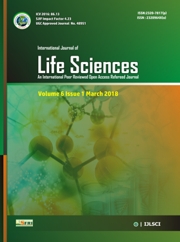RESEARCH ARTICLES
Volume 7 |Issue 5| Sept-Oct 2019 First published: 30 October 2019
Shelf life Studies on Bifenthrin 10 EC using GC-FID
Rashmi Urkude
Department of Chemistry, Shri Shivaji Science College, Nagpur-440012, India
Abstract
Keywords: Bifenthrin, GC-FID, EC formulation, BIS specifications
Editor: Dr.Arvind Chavhan
Cite this article as:
Urkude Rashmi. Shelf life Studies on
Bifenthrin 10 EC using GC-FID, Int. Res.
Journal of Science & Engineering, 2019, 7 (5):
101-104.
References
1. Kazemi M, Tahmasbi AM, Valizadeh R, Naserian AA, Soni A. Organophosphate pesticides: a general review. Agricultural Science Research Journal, (2012);2(9): 512– 522.
2. Rao GVR, Rupela OP, Rao VR, Reddy YVR. Role of bioinsecticide in crop protection: present status and future prospects. Indian Jounal of plant protection, (2007); 35(1):1:9.
3. Bifenthrin Pesticide Fact Sheet; U.S. Environmental Protection Agency, Office of Prevention, Pesticides, and Toxic Substances, Office of Pesticide Programs, U.S. Government Printing Office: Washington, DC, 1988.
4. Tomlin CDS. The Pesticide Manual, A World Compendium, 12th ed.; British Crop Protection Council: Surry, England, 2000; 502-504.
5. Vam Emden HF & Peakall DB. springer, Promotion of Dairy Husbandary for Sustainable Livelihood: BAIF’S Approach. (1996); 2:654.
6. BIS: Bureau of Indian standards: Indian Standard Specification for Bifenthrin EC IS 15936-2011.
7. Kochhar SR and Urkude R. Studies on PhysicoChemical Properties of Commercially Available EC Formulations of Deltamethrin and Profenofos pesticides. International Journal of Advanced Research, (2014) ;2(6): 972-978.
8. Urkude R & Kochhar SR. Studies on physico-chemical properties of synthetic pyrethroids Fenvalerate and Alphamethrin. Pelagia Research Library Der Chemica Sinica, (2015);6(6): 21-27.
9. Urkude R & Kochhar SR. Studies on Physico chemical properties of o-o diethyl-O Quinoxalin -2- Yl phosphorathioate for quality control. Research Journey International; E. Research Journal, special issue (2019);110 (B): Chemistry.

